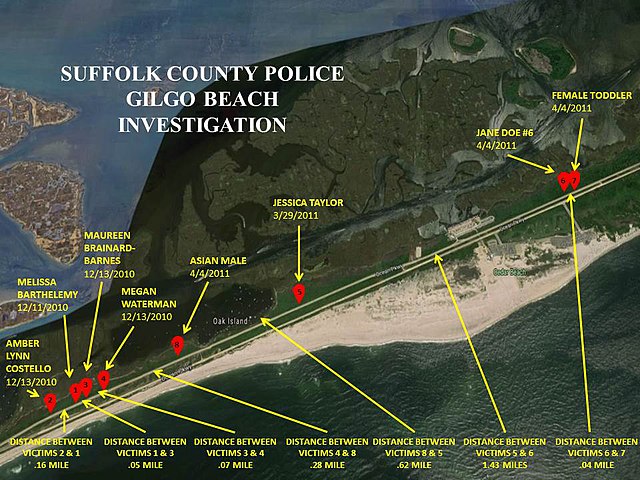It would be understandable if you’ve never heard about our subject for today. After all, until 2010, nobody knew he even existed. But then a routine police search uncovered his evil deeds to the entire world.
Soon, it became apparent what investigators had stumbled upon – it was the dumping grounds of a serial killer; one who had been active for over a decade completely unknown to the authorities, who casually discarded the dismembered remains of his victims in the same area and got away with it time and time again.
And he still eludes justice. Investigators might have a profile and a few solid suspects but, ultimately, the murderer’s identity remains a mystery. We simply know him as LISK – the Long Island Serial Killer.
A Gruesome Discovery
This story starts somewhere in the middle, on May 1, 2010, in a small, remote community in New York State called Oak Beach. It is located on Jones Beach Island, which is one of the barrier islands that make up the southern coast of Long Island. That was where Shannan Gilbert, a 24-year-old escort from New Jersey, met up with a client.
In the early hours of the morning, Gilbert ran out into the neighborhood screaming for help. A neighbor named Gus Coletti opened his door, but when he asked Gilbert what was the matter, she was clearly in a frenzied state, only saying “help me, help me” over and over again. Coletti went inside and called the police, but Shannan Gilbert disappeared before they arrived.
Authorities kept searching for her over the following months. Officially, this was a “missing persons” case, but the circumstances didn’t really anticipate a happy ending and, soon enough, police extended their search to areas where you might expect to find a body. This strategy paid off, except that nobody was really expecting or prepared for the discovery they were about to make.

It was December 11, 2010, about nine months after Shannan Gilbert’s disappearance. A K-9 unit was conducting a routine search through a weedy area to the side of the Ocean Parkway that traverses Jones Beach Island, close to a small community called Gilgo Beach. The dog and its handler stumbled upon skeletal remains coming out of a burlap sack which had almost disintegrated. The bones turned out to belong to a 24-year-old woman, but they did not belong to Shannan Gilbert. In fact, the body was later identified as Melissa Barthélemy who lived in the Bronx. She went missing outside of her apartment on July 12, 2009, and in the weeks that immediately followed, her younger sister received multiple vulgar, taunting phone calls from a strange man who said that Melissa was dead.
A couple of days after the discovery of Melissa’s body, police returned to the scene, this time with more manpower. They had a suspicion that there was still more to be found in the area. They were right, but again, it was not the remains of Shannan Gilbert. Instead, police found the bodies of three more victims, all located within 500 feet of each other. In an interview, Suffolk County Police Commissioner Richard Dormer said what everybody else was thinking: “Four bodies found in the same location pretty much speaks for itself. It’s more than a coincidence. We could have a serial killer.”
ID’ing the Victims
A few days later, the FBI was brought in to help with the search. The medical examiner concluded that all the remains belonged to young women and used dental records, DNA comparisons, and facial reconstructions to try to identify them. Together, the victims were referred to as the “Gilgo Beach Four,” also including the earlier discovery of Melissa Barthelemy who had yet to be identified at this stage.
It was in January 2011, about a month after the gruesome find, that the first identification was made. The victim was Megan Waterman, a 22-year-old woman who disappeared on June 6, 2010, last seen leaving the Holiday Inn Express in Hauppauge, New York. The other three women were also identified later that same month. One was the aforementioned Melissa Barthelemy. The remaining two were Maureen Brainard-Barnes, a 25-year-old single mother from Norwich, Connecticut, who disappeared back in July 2007, and Amber Costello, a 27-year-old woman who appeared to be the most recent victim, having gone missing on September 2, 2010.
Already, a clear pattern began to emerge regarding the victims – like Shannan Gilbert, all four women worked as escorts, at least on occasion. Before her disappearance, Maureen Brainard-Barnes had temporarily relocated to a cheap motel in Manhattan where she met clients. She did this as a last resort before getting evicted from her home. Megan Waterman had a boyfriend/pimp named Akeem Cruz who arranged dates for her, and even though police confiscated his laptop for info on his clients, they couldn’t find any leads for her murder. And according to Amber Costello’s roommate, she was nervous about meeting her client the night of her disappearance, but eventually relented after he offered $1,500, almost six times her normal rate.
There was another link that connected the victims. All of them offered their escort services on Craigslist. Once the media found out, some of them started referring to the culprit as the Craigslist Ripper, although others still preferred the name which was originally assigned to him, the Gilgo Beach Killer. As you are about to see, however, his area of activity extended beyond Gilgo Beach, so the name that became the most widely used was the Long Island Serial Killer, or LISK.
The Body Count Gets Higher
Authorities were fairly convinced that Shannan Gilbert’s body was still out there. However, harsh weather conditions made the search difficult, so the Suffolk County police waited until spring and went back out there in late March.
About a mile east of the original site, they found a skull, a forearm, and a pair of hands. Once again, these did not belong to Shannan Gilbert, but rather to a 20-year-old woman named Jessica Taylor. Like the others, Taylor worked as a prostitute, although it was never definitively established if she used Craigslist to find clients. There was, however, a more disturbing implication regarding the most recent find. Jessica Taylor had been murdered in 2003. Police knew this because her torso had previously been found in July of that year. It had been discovered by a woman walking her dog off a utility road in Manorville, a hamlet in the middle of Long Island. This was almost five years earlier than any of the previous victims. It immediately raised concerns that LISK had likely been active longer than everybody had expected and that there were probably more victims out there, waiting to be found.
Investigators did not have to wait long. In early April, they went out there again, slowly making their way along the Ocean Parkway. They found the remains of three more people. One of them was an Asian male in his late teens, early 20s, who was found dressed in women’s clothing. The second was a young woman, and the third, most disturbing of all, was a baby, believed to be a girl, approximately two years old.
This was a shocking revelation. Not only due to the obvious reason of finding such a young victim, but also because it contradicted everything the police thought they knew about LISK. Up until this point, there appeared to be a pattern. The killer preyed on the same kind of victim, and he seemingly used Craigslist as a convenient method of finding new targets. He usually strangled them and then dumped their remains in remote areas along Long Island’s Ocean Parkway. That pattern now went out the window because not only did the killer target a man and an infant, but he also switched his killing method, as the Asian male’s cause of death had been a blunt-force impact to the head, while the baby showed no outward signs of trauma.
Because of this significant departure, some criminologists have speculated that LISK may not have been responsible for all the murder victims found on the Ocean Parkway, and that there were two, even three killers.
To this day, the man and the child remain unidentified. They are referred to simply as Asian Doe and Baby Doe. The third victim, however, who was a woman, was only recently identified in May, 2020, thanks to genetic genealogy which allowed investigators to track down her biological relatives. She was 24-year-old Valerie Mack from Philadelphia and her situation was very similar to that of Jessica Taylor. Only her skull, hands, and part of one foot were found along the Ocean Parkway because the rest of her body had been discovered years earlier by hikers in the Long Island Pine Barrens, also located near Manorville. Like the other women, Mack worked as a prostitute and was last seen in the area of Port Republic, New Jersey. This happened in 2000, thus pushing back the timeline by a few more years, and showing that LISK, if he was indeed responsible for the Manorville killings, had been active for over a decade before anyone knew he even existed.
Search Extends to Nassau
Given that police kept finding new bodies every time they went out to search, they had no reason to assume that this problem would only be contained in Suffolk County. Therefore, the neighboring Nassau County Police Department began their own investigation. Just a week after the discovery of the remains of Valerie Mack and the two does, Nassau County investigators went out to search their stretch of the Ocean Parkway and made their own grim discoveries. They found the partial remains of two more women, one of them only a skull and some teeth.

Like some of the previous victims, these two were later connected to body parts that had been found in other areas of Long Island years prior. One of them was a young black woman whose dismembered torso had been recovered from Hempstead Lake State Park back in 1997. She still remains unidentified to this day, but is informally known as “Peaches” based on a heart-shaped peach tattoo she had on her chest. Years later, the tattoo was recognized by the artist who made it, who remembered that his client was around 18 or 19 years old and that she came from the Bronx or Long Island. More significantly, though, DNA tests performed in 2016 revealed that Peaches was, in fact, the mother of the Baby Doe whose remains were found near Gilgo Beach, creating a definitive link between two of the crime areas.
The other victim from Nassau County was only a skull, but police still managed to connect her to a pair of severed legs that were found in a garbage bag on Fire Island back in 1996. She still is only known as “Fire Island Jane Doe” and it is unlikely that she will ever be identified. As of this moment, she remains the oldest victim confidently attributed to LISK, showing us that he has been active for at least 15 years, between 1996 and 2010.
Were There More?
These are the ten victims most commonly ascribed to the Long Island Serial Killer, but this is far from a certainty. Originally, investigators worked under the belief that the area surrounding Gilgo Beach served as the dumping grounds for three, even four killers. The Suffolk County District Attorney’s Office, in particular, was adamant that there was “no evidence that all of these remains were the work of a single killer.”
This would not have been unprecedented. California’s Freeway Killer turned out to be three different murderers, who acted independently from one another, but were active at the same time, in the same place, and targeted the same victims. The Texas Killing Fields refers to a patch of land off Interstate-45 that was used as a dumping ground by several killers throughout the decades. Something similar could still be possible with LISK, but police eventually moved on from this idea as their investigation progressed. They concluded that there were enough “common denominators” between the crimes to suggest one culprit due to the type of victim, the dismemberment, and the dumping grounds.

In December 2011, a year-and-a-half after it started, police finished the search that launched this entire investigation – they found the body of Shannan Gilbert, the escort who was last seen fleeing a client’s home in Oak Beach. If they had never started looking for her, they might have never stumbled upon the remains in Gilgo Beach, and the world might still be blissfully unaware of LISK’s existence. But curiously, investigators concluded that Gilbert was not among the killer’s victims. Her remains were found in a swampy marshland, about half a mile from where she was last seen, and police believe that she drowned accidentally while running away. Her family disagreed, and organized an independent autopsy, where the pathologist found that Gilbert had sustained injuries “consistent with homicidal strangulation,” but was unable to say with certainty that she was murdered.
For the moment, Shannan Gilbert remains a possible connection to the case, but she is not the only one in this situation. In 2013, a 31-year-old woman named Natasha Jugo disappeared while leaving her home in Queens. Her car was found abandoned on Ocean Parkway and her body washed up on Gilgo Beach soon after. Also in 2013, the skeletal remains of an Asian woman were found in Nassau County, in a garbage bag near Oyster Bay. She is still unidentified, but was probably between 20 and 30 years old and was wearing a necklace with a 24 karat gold pig pendant. The dismembered remains of a woman named Tina Foglia were found in three separate garbage bags, just a few miles from the Robert Moses Causeway that leads to Gilgo Beach. This could possibly be linked to LISK, but she was killed way back in 1982, in what is either an unrelated crime or, perhaps, the killer’s earliest murder.
And there are more. As you can see, all of these cases have things in common with LISK, whether it is the location, the victim similarity, or the vicious dismemberment. However, it is almost impossible to prove a definitive connection, so unless we eventually identify LISK and get a confession, there will always be doubt over the true number of victims.
Who Is He?
Now we arrive at the million dollar question – who is the Long Island Serial Killer? Well, we can’t answer that, not at the moment at least. LISK remains unidentified and at large, but that could change in the near future. Unlike other notorious and unnamed serial killers like the Zodiac or the Mad Butcher of Kingsbury Run, this is very much an active investigation, with new developments every year. Like we previously mentioned, it wasn’t until earlier in 2020 that one of the victims, Valerie Mack, was finally identified. Also at the beginning of the year, police came forward and presented a key piece of evidence, hoping that someone might recognize it. It was a black leather belt with the initials “WH” or “HM” embossed on it, depending on how you held it. A spokesperson for the police also mentioned that they did not believe the belt belonged to any of the victims, but would not specify if it had any DNA on it or if it had been used as a murder weapon.
Unfortunately for us, an active investigation also means that police can be very scarce with the details made available to the public. The leather belt, for example, was discovered at one of the original crime scenes back in 2010, and it wasn’t until a decade later that they finally went public with it.
That is also why the most detailed profile on LISK that’s accessible to us had been compiled by the New York Times, using only publicly-available information. They said that LISK is “most likely a white male in his mid-20s to mid-40s. He is married or has a girlfriend. He is well educated and well spoken. He is financially secure, has a job and owns an expensive car or truck. He may have sought treatment at a hospital for poison ivy infection. As part of his job or interests, he has access to, or a stockpile of, burlap sacks.”
And according to one of their expert consultants, LISK is a “psychosexual sadist” who derives pleasure from the murder itself, meaning that he kills for the sake of killing rather than having any additional motives. This also lends itself to other similar impulses, such as calling the victims’ families to taunt them. Lastly, the profile points out that there might be a seasonal component to the killer’s activity, since most of his victims went missing in summer or early autumn.
This profile was partially corroborated by an unlikely source – Joel Rifkin, probably New York City’s most prolific serial killer. For a while, people have speculated that some of the victims could have been killed by Rifkin because he used to live in Long Island for a time. He has denied this, saying that he has “nothing to do with those bodies.” Even so, he would have only been eligible for the earliest victims, like Tina Foglia, since he was apprehended back in 1993. Anyway, Rifkin might have no involvement in these killings, but he believes that the culprit is someone who would go unnoticed while walking around with big burlap sacks, someone like a fisherman or landscaper. He also thinks that LISK is a local since he appears to have a connection with the area surrounding Gilgo Beach, where he dumped the remains.
With no official profile released by the police or the FBI, other sources gave their two cents. After consulting with a few experts, ABC News floated the possibility that LISK might have had some sort of involvement with law enforcement because he seemed to display knowledge of police procedures. Whenever he called his victims’ families, he made sure to do it from a very crowded place like New York’s Penn Station, and he never stayed on the line for more than three minutes.
The Suspects
Profiles aside, do investigators have any actual suspects in the killings? Well, yes, as a matter of fact, they do have a few, and their strongest candidate is a man named John Bittrolff, who happens to be a convicted serial killer who also lived in Manorville, the place where the body parts of several victims were found soon after they had been killed. And he also worked as a carpenter, meaning that he had plenty of cutting tools and burlap sacks.
Bittrolff first appeared on the police’s radar in 2013 when his brother Timothy was arrested for a misdemeanor. As standard procedure, he submitted a DNA test, which was later flagged as a match to DNA found at two murder sites: those of Rita Tangredi in 1993 and Colleen McNamee in 1994, both beaten to death and strangled. The match was only a partial, which meant that Timothy Bittrolff was not the culprit, but the two were related. That is how police eventually arrived at John Bittrolff, who has since been convicted in 2017 and is serving two consecutive 25-to-life sentences.

Ever since Bittrolff was identified, he was also suspected in a third unrelated murder, but after his conviction the prosecutor specified that he was being investigated in, at least, some of the crimes attributed to LISK. The killings do seem to have a lot of things in common. Bittrolff’s victims were found in Suffolk County where Gilgo Beach is located. They were also believed to work as escorts and there is even a personal connection between Rita Tangredi and one of LISK’s victims, Melissa Barthelemy, who was allegedly best friends with Tangredi’s daughter. Bittrolff’s murders lacked the horrendous mutilations of LISK, but since his were committed in the early 90s, it would not be unheard of for a killer to escalate the level of violence.
The investigation into Bittrolff is ongoing, but what if someone else is the culprit? After all, it’s highly unlikely that John Bittrolff will ever be released from prison, whether or not he is LISK. But if he is not the Gilgo Beach Killer, then focusing solely on him would allow the real culprit to evade justice.
Admittedly, there are a few more named suspects, but none of them make as good a case as Bittrolff. One would be Joseph Brewer, the man who hired Shannan Gilbert off Craigslist the night of her disappearance. He would make a pretty obvious candidate, but police said that he cooperated fully with the investigation and was dismissed as a suspect years ago, especially since later reports claimed that Gilbert partied with a second, unidentified man after she was finished with Brewer.
Just late last year, a man from Long Island named Andrew Frey was arrested on multiple counts of attempted kidnapping and sex trafficking. Two prostitutes came forward, claiming that he allegedly tried to take them to a secluded area by force, both having escaped by jumping out of his moving car. Afterwards, several other escorts claimed that they have had violent encounters with Frey, one even saying that she was forced to take out an order of protection against him, which he violated by calling her and leaving her threatening voicemails. New York authorities said that Frey has a “propensity to commit violence against female sex workers,” but since the case is ongoing, he has yet to be convicted of anything and there haven’t been any connections established to the Gilgo Beach murders.
Unlike most of the other killing sprees that involve unidentified murderers, this one is an active investigation with a genuine chance of reaching a conclusion. Who knows, maybe a year or two from now, the identity of the killer will be discovered and we can do a follow-up video on LISK. But until then, thanks for watching!



